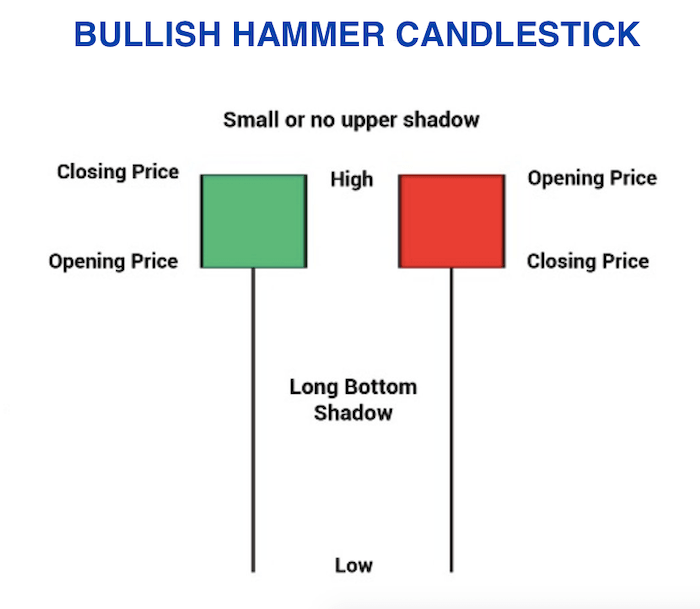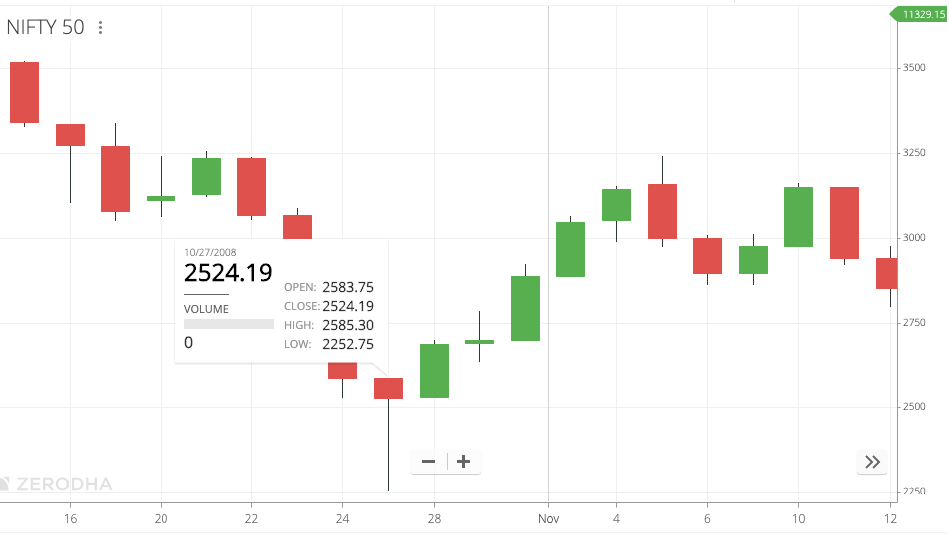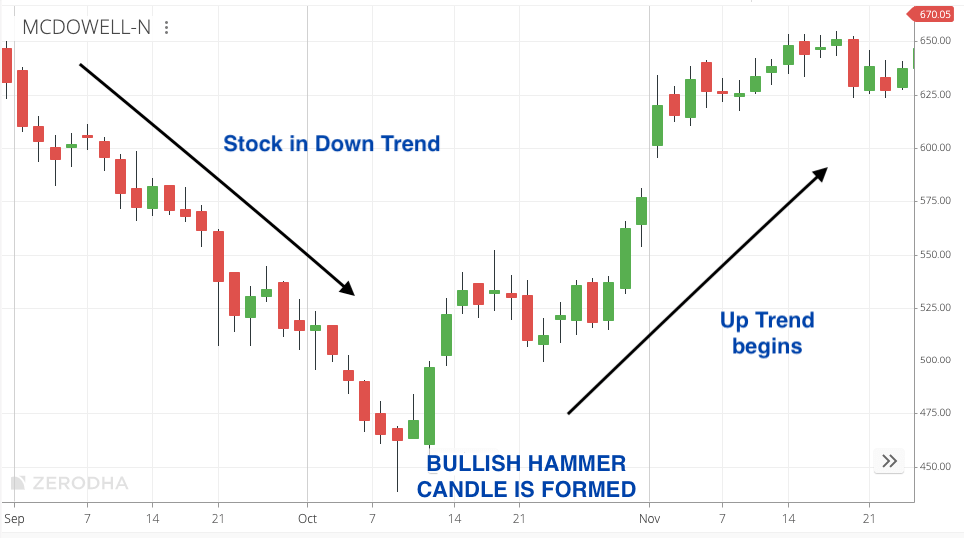A ‘Hammer’ candle has a short body with a long tail. When this candle appears during a downtrend, it signals a potential turnaround from downtrend to uptrend.
The colour of the candle does not matter. The ‘Hammer’ can either be red or green.

The ‘Hammer’ gets formed when the price moves significantly lower than its opening price.
The price hits a low and then rises drastically to close near its opening.
For example, if the price of HDFC Bank opens at 1000, falls to 900 and then rises to close at 1025 – a candle that looks like a ‘hammer’ will be formed on the chart.
When the ‘Hammer’ candle appears during a downtrend, it’s considered to be a ‘trend reversal’ candle.
In simpler words, if a ‘Hammer’ gets formed on the chart after a stock has fallen, it could mean the bottom has been formed and the stock could move higher.
Because the price is expected to rise, the ‘hammer’ candle is also called as ‘Bullish Hammer’.
How traders use ‘Bullish Hammer’ Candle
Trend reversal is confirmed if the next candle after the ‘Bullish Hammer’ closes above the closing price of the hammer.
If the previous few candles are moving downwards and a ‘Hammer’ candle is formed, it’s usually considered to be a sign of bottoming out.
Hammers can be used in combination with trend lines and other technical indicators to confirm the trend reversal.
Examples of ‘Bullish Hammer’ on Charts

The most famous ‘Hammer’ candle in the Indian stock market was formed on October 27 2008.
The Nifty 50 hit an all-time high of 6357 on January 8 2008. A few days later, the market began to crash. What followed was one of the most devastating bear markets the country has ever seen.
For more than a year the bear run continued. Most people sold their shares and left the stock market, vowing to never return again.
The lowest point of the 2008-crash was on October 27 2009. The date when the ‘Bullish Hammer’ candle was formed on the daily chart.
The Nifty 50 opened at 2583, crashed to a low of 2252, rose to a high of 2585 and closed at 2524. On this day, the market witnessed ‘panic selling’.
If you were an investor on this day, you could’ve bought Bajaj Finance for ₹ 7 and Kotak Bank for ₹ 60. Almost all stocks were being sold for throwaway prices. Majority of market participant strongly believed that the market will crash further.
But it is at this point the ‘Hammer’ candle got formed on the chart and the market began to recover.
The ‘trend reversal’ was confirmed on the next day when NIFTY opened at the same level as its closing on the previous day and rose further up during the day.
There are many such examples of ‘Bullish Hammers’ getting formed on the chart. It can be effectively used for short term and long term trades – when a stock is in a downward trend.
Another classic example of Bullish Hammer:

In the United Spirits example above; the stock is in a downtrend. On October 9 2018, the stock opens at 468, falls to 438 and closes at 462. The ‘Hammer’ gets formed.
On the next day, the stock opens and does well again forming a green (bullish) candle. This partially indicates that the trend reversal is more or less confirmed.
The following day, the trend reversal is 100% confirmed. A huge bullish candle is formed and the stock did very well for the next couple of months.
Bullish Hammer for Long Term Investors
Long term investors can wait for ‘trend reversal’ candles and patterns to buy quality stocks close to the bottom.
Most investors do the mistake of ‘averaging’ stocks as the price falls. A better strategy would be to wait for the stock to fall and buy once the trend reverses on the upside.
It could mean buying 10-15% higher than the bottom, but the price will still be comparatively lower than averaging during downtrends.
This strategy will require a lot of patience, but can prove to be very effective when candles like ‘Hammer’ are used in combination with other technical indicators.

These articles are so insightful and driven by real world data. Thank you so much for explaining these concepts!
What’s the logic behind calling it ‘hammer’ candle
Yes it is correct
It looks like a hammer.
Very well written in an easy to understand language and illustrated beautifully.
If Mr.Ashok has written an book on Technical Analysis,please let me know along with name of publisher, year of publication , cost of the book etc.I would like to buy his book.